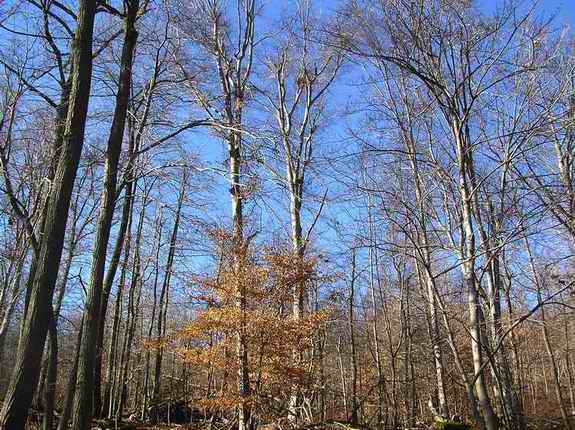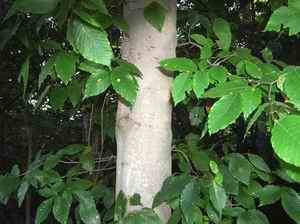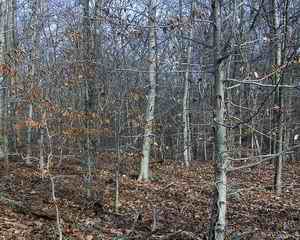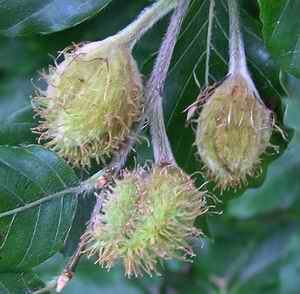|
Return to Hiker's Notebook Home Page
Common Name: American Beech, Red beech, Carolina beech, Gray beech, White beech, Stone beech, Winter beech - Beech is of Anglo-Saxon origin and is derived from the Norse languages as a synonym for book (bok in Old Norse and Swedish, buoh in Old High German). Thin slices of beech were used for the carving of runic characters; the beech was thus the earliest form of European book.
Scientific Name: Fagus grandifolia - The generic name is Latin for beech tree, which is derived from the Greek "to eat" in reference to the edible beech nuts. The species name means "large leaves" in Latin. Sometimes called Fagus americana.
The American beech is the namesake member of the Fagaceae or Beech family, which is comprised of the oaks (Quercus), the chestnuts and chinkapins (Castanea) and the beeches (Fagus). The characteristic of the trees is that they bear edible fruits that are in the form of either one-seeded nuts or in a protective cup structure with two to three nuts. The European beech (F. sylvatica) is very similar and has been introduced as an ornamental; its popularity in Europe is exemplified by Fagus, the Celtic god of the beech tree, a significant deity in the southern area of ancient Gaul. Smooth, silver-grey bark is the most distinctive characteristic of beech trees; since they are relatively slow growing and long-lived they make ideal repositories for anthropogenic memorials. This time-honored practice is manifest in the name of the tree; beech is an anglicized form of the word for book due to its use as a means of documentation in the ancient runic languages of northern Europe. Accordingly, the European beech is also known colloquially as bog, buk, boke and buke. The most noted of inscribed beech trees was the so-called President's Tree of Tacoma Park, Maryland, which carried the names of every president from Washington to Lincoln. It was carved in August 1865 as a tribute to the post-bellum continuity of the union; it was blown down by a storm in 1997.
The thin bark of the beech does not afford much protection to the tree; they are particularly susceptible to damage by fire, sunscald and winter frost. Beech trees are also subject to infestation by over seventy parasitic fungi, more than any other hardwood species; among the more notable of the fungi are the Artist's Conk (Ganoderma applanatum) and the Tinder Fungus (Fomes fomentarius). The beech is also vulnerable to a large number of insect predators; some, like the beech bark aphid (Fagiphagus imbricator), are named for their prey (Fagiphagus means beech eating).
The American Beech and the Sugar Maple are the two dominant species in one of the primary climax communities of eastern deciduous trees: the Beech-Maple forest. The mixture of trees is such that the canopy is primarily comprised of one of the two tree species with the other species dominating the understory. Experiments have shown that Sugar Maple seedlings grow best under Beech trees and that Beech seedlings grow best under Sugar Maples. Over time, the canopy tree species will shift from one to the other as the seedlings grow and the older trees die, a relationship known as frequency-dependent selection.
Beechnuts are encased in a woody husk that is covered with spines, each containing two irregularly triangular shiny brown edible nuts. They are only produced after the beech has reached the age of about 40 years; annual beechnut production ramps up at this point to reach maximum yields after at about the 60 year point. Beechnut production is cyclic; prodigious quantities appear in highly variable 2 to 8 year periods, a process known as masting. Beechmast is a very important food source for many birds and animals, notably chipmunks, black bear, ruffed grouse and blue jays. Beechnuts were eaten by Native Americans and to a lesser extent by the early colonists, primarily when more desirable agricultural and faunal food sources were scarce. The nuts are mildly toxic and have a high level of tannin, making them less desirable than alternative walnuts and hazelnuts, which were also consumed. Numerous Indian tribes, including the Potawatomi, Algonquin, Menominee and Ojibwe ate them raw, to no noted ill effect; beechnuts were also roasted and pounded into meal for bread and chewed as a means to expel worms, possibly taking advantage of their toxicity. Nuts were frequently collected by taking advantage of the hoarding habits of rodents; the tracks were followed in snow to a cache in a hollow tree where as much as eight quarts of beechnuts might be found. The colonists ground beechnuts into powder as an ersatz coffee and pulped them to produce an oil that was used in cooking, as salad dressing, and as fuel for oil lamps. The residual dregs from the oil production process are considered by some to be a good source of animal feed; others considered it toxic with some evidence that animals had died from its ingestion.
The beech tree is the primary source of a type of creosote that has been used for a variety of medicinal applications. This is different from coal tar creosote which is used as a wood preservative and is poisonous. The active ingredient of beech creosote is guaiacol, which was taken internally as an antiseptic and a stimulant and used as an expectorant for chronic bronchitis and other respiratory problems. Applied externally, it was used to treat the pain of swelling and blisters; creosote tar was chewed to sooth chapped lips and to provide relief from gum pain. Native Americans made a tea from beech bark that was used topically on poison ivy rash; taken internally, the tea was used to ameliorate stomach disorders and to stimulate the appetite.
Beech wood is characterized by high density, shortened grains that make it easy to work while at the same time reducing the toughness; beech wood is brittle. The ease with which it can be turned on a lathe and bent into shapes with the application of steam make beech wood one of the mainstays of furniture manufacture. Although it is not generally used in outdoor applications, its durability is enhanced under conditions of continuous wetness; beech wood was therefore used extensively for waterwheels and for sabots, or wooden shoes to accentuate water repellency in boggy areas. |


 A
second distinctive characteristic of beech trees is their growth pattern and
winter leaf persistence. Beech trees have a shallow root system that sends
out many shoots known as root suckers. A mature beech can have twelve or more
sucker stems that amount to small saplings surrounding the older tree. Studies
have shown that root sprouts are the primary means of reproduction in what
are known as "beech gaps." Counts of the numbers of beech sprouts range from
700 to 900 per acre. Since beech leaves are retained by the tree through the
winter, these dense stands of beech saplings are quite evident in the forest
understory.
A
second distinctive characteristic of beech trees is their growth pattern and
winter leaf persistence. Beech trees have a shallow root system that sends
out many shoots known as root suckers. A mature beech can have twelve or more
sucker stems that amount to small saplings surrounding the older tree. Studies
have shown that root sprouts are the primary means of reproduction in what
are known as "beech gaps." Counts of the numbers of beech sprouts range from
700 to 900 per acre. Since beech leaves are retained by the tree through the
winter, these dense stands of beech saplings are quite evident in the forest
understory. 